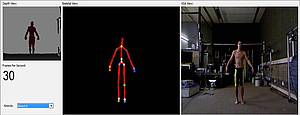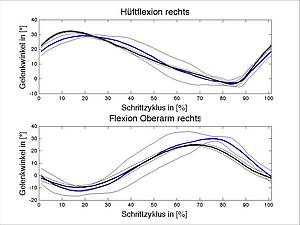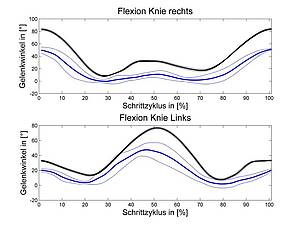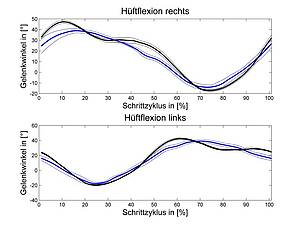Ganganalyse mit der Microsoft Kinect
VORBEMERKUNG
Dieses Projekt wurde in Kooperation mit dem Institut für Biomechanik und Orthopädie der Deutschen Sporthochschule in Köln durchgeführt.
BACKGROUND
Investigating human motion with expensive and accurate optical´marker systems has been the state of the art since long ago. However, markerless low-cost systems have always been a desideratum in the field of biomechanics and sports science. Due to increasing computer chip power and the corresponding progress in image processing techniques the realization of such a system has become feasible. With the advent of the Microsoft Kinect sensor in 2011 a flexible low-cost tool has entered the computer game market that enables markerless tracking of human motion.
AIMS
At first sight the Kinect provides an amazing accuracy. The goal of the present work is to quantitatively investigate the tracking accuracy of the Kinect sensor by studying the human gait cycle on a treadmill. The Kinect results are compared with data stemming from a VICON system which is regarded as gold standard. Subsequently, a post processing algorithm is applied to the Kinect data using anthropometric data as a priori information in order to enhance Kinect’s tracking results.
METHODS
The Kinect sensor provides a skeleton model whose measured joint positions and segment lengths only roughly match those of the VICON system. A first inspection of the measurements and their accuracy reveals that segment lengths determined by the Kinect system are considerably varying in time (up to +/-20% at the most). In order to freeze the length of all segments the Levenberg-Marquardt-algorithm (LMA) is applied to the Kinect data. LMA manipulates the Kinect joint positions such that the segment lengths of the Kinect skeleton to be become identical with pre-defined lengths.These segment lengths of the original human being can easily be determined by previous manual measurements. In our special case we use the data provided by the VICON system.
RESULTS
The comparison between both systems shows that the Kinect sensor is currently not able to provide anthropometrically reliable segment lengths. However, this failure of the Kinect system is healed with our optimization procedure. When looking at the segment angles relevant for the human gait cycle the Kinect sensor provides an astonishing accuracy.
CONCLUSION
Our work shows that the Kinect sensor is already capable of describing the motion of walking and running with an acceptable accuracy in the frontal plane. Additionally it is proven that a posteriori optimization using a priori available knowledge can improve the tracking accuracy of the anatomical landmarks. That does not mean the Kinect sensor is now ready for use in highly sophisticated scientific applications, but it can already be applied for basic research in simple clinical test cases. In the future, the Kinect might become a serious competitor for other motion analysis systems.












